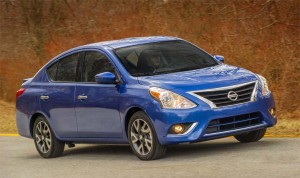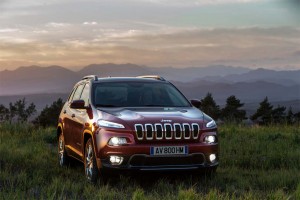Recent big swings in the stock market and dire headlines about an economic downturn haven’t put any kind of dent in U.S. auto sales, industry analysts are predicting demand for October will be up between 5.4 and 6.0% when sales numbers are totaled up next week.
Total demand, including retail and fleet sales, is expected to reach 1.27 million vehicles, according to various forecasts. On an annualized basis, known in industry terms as the SAAR, that would work out to 16.3 million vehicles, nearly a million about the rate for all of 2013.
“The industry continues to demonstrate strong sales growth and robust transaction prices, resulting in another record-breaking month for industry consumer spending,” said John Humphrey, senior vice president of the global automotive practice at J.D. Power and Associates.
Fleet volume is expected to be 203,000 units, or 16% of total light-vehicle sales, according to forecasts by both Power and Kelley Blue Book.

The 2015 Nissan Versa is selling at a better clip than most subcompacts this year. Its sales are up 20% over last year.
Helping make the numbers look good, October is typically the second weakest month of the year for sales, only above January. Many consumers take advantage of Labor Day deals in September, or wait for Black Friday and other holiday sales to come later this year, noted senior KBB analyst Alec Gutierrez.
The newly minted Fiat Chrysler Automobiles should enjoy another strong month with expected growth approaching 20%. Once again, the big draw has been the new Jeep Cherokee, which launched late last year. If you exclude the Jeep Cherokee, Fiat Chrysler’s impressive growth for the first nine months of 2014 dropped from 14.7 to just 5.2%.
Nissan North America also is expected to post double-digit gains, making great strides this year in the small car segments, which is especially notable considering there isn’t much strength in these segments. The little Versa is up 20%, while subcompacts are up 4.5% overall, and the Sentra has increased 44%, while compact cars are only up 1.7%.
Models like the Toyota RAV4, Subaru Forester and Nissan Rogue are expected to help compacts SUVs remain the industry’s fastest growing segment. As a result of consumers opting for these small utility vehicles, market share for compact and midsize cars will continue to fall, analysts are forecasting.
Fiat Chrysler has clearly benefited from this shift as it is expected to pick up 1.3 points of market share in October as buyers moved towards light-duty trucks and SUVs.
(Fiat Chrysler set to spin off Ferrari. For more, Click Here.)
“As Ford is forced to manage their inventory of the F-Series, we wonder if Fiat Chrysler and General Motors will make the most of the market opportunity,” said Gutierrez. “Big gains are expected from the Ram pickup and solid numbers should be reported for both the Chevrolet Silverado and GMC Sierra.”
Overall Ford has lost more than one full point of market share so far this year. It is hoping to regain momentum with the upcoming launch of its all-new F-150 pickup, but analysts warn of a potentially slow ramp-up of production.
SUV sales have increased 12% for the first three quarters of 2014 compared with 2013, while total new-vehicle sales have increased 5% for the same period. SUVs are expected to account for 34% of the light-vehicle market in 2014, up from 32% in 2013, analysts said.
(Click Herefor details about Fiat Chrysler’s earnings.)
“One cause for concern is the rising levels of incentive spend in the industry, which in recent months has drifted close to an average of $3,000 per vehicle,” Gutierrez cautioned.
“The ratio of incentive spend to average transaction prices is at its highest since 2010, but remains below pre-recession levels. Since inventory levels have remained consistent, this isn’t a red flag quite yet, but it does underline that the natural industry growth we’ve had in recent years is slowing,” he said.
(Automakers still focusing on cost over quality, suppliers claim. Click Here for the report.)
J.D. Power analyst Humphrey also noted consumers are adopting longer-term financing which makes purchases more affordable from a monthly payment perspective. Nearly one-third – 32.6% – of all vehicles sold in October 2014 are expected to come with loan terms of 72 months or longer, tying the record set in July 2014.
Vehicle inventory at the end of September was at a 64-day supply, up from 56 days at the end of August, but still within the industry norm.
“The current environment of the auto industry is one of strength and stability, with the second half of the year at a 16.6 million-unit pace, more than making up for the 16.1 million unit level in the first half of 2014,” said Jeff Schuster, senior vice president of forecasting at LMC Automotive. “The market is clearly seeing a second wave of SUV popularity – with a wide variety of choices across the size spectrum – that will likely dominate market share for the foreseeable future.”

